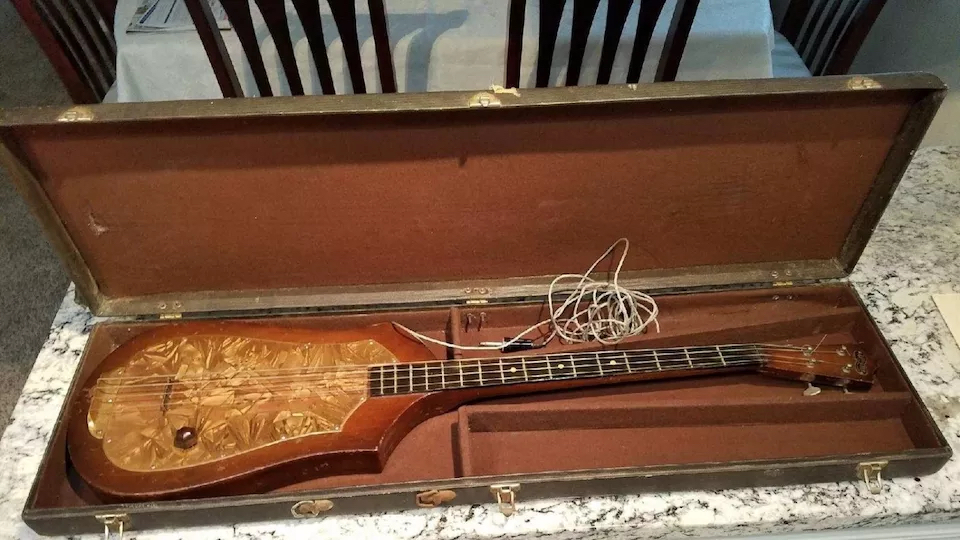The bass guitar was invented by Paul Tutmarc in the 1930s. His creation, the Audiovox 736, was the first modern electric bass.
In the meantime, don't forget to unlock a world of unlimited sound with Amazon Music Unlimited, where over 100 million songs wait at your fingertips. Whether you're working, relaxing, or fueling your creativity, the right track is always just one tap away. Elevate every moment with music that moves you.
The birth of the bass guitar revolutionized music, offering bands a more practical alternative to the upright bass. Paul Tutmarc’s brainchild allowed easier transportation and amplified sound, suiting various music styles. His design has since evolved, with creators like Leo Fender popularizing the instrument further in the 1950s.
The bass guitar now holds a crucial role in rhythm sections, laying the foundation for genres from rock to funk. It’s an essential tool for musicians, providing depth and harmony to compositions. Its invention marked a significant turning point in the way music is performed and experienced.
Introduction To The Bass Guitar
Embarking on a rhythmic journey through history, the introduction to the Bass Guitar unveils a musical saga that revolutionized the sound of ensembles and genres across the board. Often seen as the backbone of a group’s harmonic framework, the Bass Guitar brings a distinct depth and foundation to music. This captivating narrative begins with the need for a more practical, yet sonically powerful instrument.
Defining The Bass Guitar
At the core of the Bass Guitar’s identity is its role as a stringed instrument, primed for producing low-frequency tones. It typically features four to six strings and comes in both electric and acoustic varieties. Unlike lead guitars, basses focus less on melodic leads and more on underpinning the harmonic structure of music with rich, resonant basslines.
The Role Of Bass In Music
In any musical composition, the Bass Guitar plays a pivotal role. The instrument’s low-end vibrations are essential for creating a full, balanced sound. Acting as the bridge between rhythm and harmony, the bass outlines chord progressions while syncing with the percussion to drive the tempo and feel of a track.
- Bass maintains rhythm alongside drums.
- It provides harmonic context for melodies.
- Bass lines establish the groove or feel of a song.
Evolution From Upright Bass To Bass Guitar
The catalyst for the Bass Guitar’s invention was the need for a more versatile and portable instrument compared to the cumbersome upright bass. In the early 1930s, inventors began experimenting with design and amplification techniques leading to the creation of the bass guitar as we know it. The Fender Precision Bass, introduced in the early 1950s, marked a significant milestone in this evolution, offering a compact design with frets to ensure accurate intonation.
| Year | Development |
|---|---|
| 1930s | Initial design and experimentation |
| 1950s | Introduction of the Fender Precision Bass |

Credit: www.seattletimes.com
Historical Context Of The Bass Guitar’s Invention
The bass guitar, as we know it today, is the product of a series of innovations and a response to the musical demands of its time. Its invention was not an isolated event, rather a result of the evolutionary changes in music and technology. To appreciate the full depth of the bass guitar’s creation, it is essential to consider the historical backdrop against which it was developed.
The quest for prominent, hearty bass sounds capable of complementing increasingly complex musical arrangements set the stage for an instrumental revolution. With progress in various genres of music and the advent of new performance venues, the roles and requirements of bass instruments began to shift dramatically.
Early Attempts At Amplified Bass
The double bass reigned supreme in the early 20th century as the backbone of rhythm sections in jazz and swing bands. The intrinsic issue of low volume, however, proved to be a hurdle in larger venues. This challenge led to early attempts at amplifying bass sounds, laying crucial groundwork.
- Experiments with electric pickups for the double bass
- Advent of primitive amplification systems
- Innovation with materials and design variations to improve sound projection
The Emergence Of Rock And Roll
The 1950s heralded the rise of rock and roll, energetically reshaping the music scene. This explosive genre demanded instruments that could mirror its vitality and sustain. It was within this context that the bass guitar found a fertile ground to evolve, greatly benefitting from the electrification of instruments.
| Musical Genre | Instrumental Requirement |
|---|---|
| Rock and Roll | Louder bass with a strong presence |
| Blues and RB | Deep, mellow tones |
| Jazz | Smooth, flowing bass lines |
Demand For A More Portable Bass Instrument
As musical tours and the frequency of performances increased, an important need arose: portability. The cumbersome size of the double bass posed logistical challenges for musicians on the move, thus creating demand for a compact, portable bass instrument.
Enter the solid-body electric bass guitar: a manageable, transportable solution that offered consistent sound and volume, unaffected by the acoustics of differing performance spaces. Innovators such as Leo Fender revolutionized the bass, making it an indispensable part of the modern music toolkit.
Leo Fender And The Invention Of The Precision Bass
The electric bass guitar stands today as a cornerstone of modern music, delivering the essential low end that gives contemporary genres their depth and drive. At the heart of its history is Leo Fender, an inventor who forever changed the landscape of music with the creation of the Precision Bass. Let’s dive into the life of Leo Fender, the groundbreaking design of his iconic bass, and the lasting impact it has had on the music industry.
Leo Fender’s Background
Leo Fender, born in 1909, was not a musician himself but had a profound passion for electronics and the mechanics of sound. With a background in accounting and electronics, Fender started his own radio repair shop in the 1930s, which later expanded into the creation of amplifiers and electric instruments.
Design And Development Of The Fender Precision Bass
Leo Fender revolutionized music with the introduction of the Fender Precision Bass in 1951. His vision was to create an electric bass that could provide precise intonation, a persistent issue with the stand-up basses at the time. Working closely with musicians, Fender prototyped a bass guitar that featured frets for accurate notes – a design trait that earned it the ‘Precision’ name.
Technical Innovations And Features
- Solid body design to reduce feedback problems
- Frets for precise note playing
- Single pickup to capture the string vibrations
- Volume and tone controls for sound customization
The Precision Bass came with a 34-inch scale length and four strings, tuned similarly to a double bass, making it familiar to bassists while offering enhanced playability and sound quality.
Impact Of The Precision Bass On Music Industry
The arrival of the Precision Bass profoundly influenced music making. It allowed bass players to contribute more pronounced and consistent bass lines in live performances and recordings. Its ease of use, combined with an affordable price point, enabled a broader expansion of low-end sounds in various music styles, including rock, jazz, and blues.
| Area of Impact | Changes Introduced |
|---|---|
| Live Performances | Enhanced audibility of bass, leading to more dynamic stage presence. |
| Recording Industry | Better sound quality and easier integration into multi-track recordings. |
| Music Education | Fender’s bass guitar became a standard instrument for budding bassists. |
The Fender Precision Bass ultimately shifted the role of the bass in band settings, elevating it from a background rhythm component to a central, defining element of modern music.

Credit: www.openculture.com
Subsequent Developments And Variations
After the revolutionary creation of the electric bass guitar, the musical world witnessed a continual evolution that reshaped its presence in various music genres. Each development and variety that emerged played a critical role in sculpting the bass guitar’s legacy. Let’s delve into the fascinating journey of this instrument through its subsequent developments and variations.
Competing Brands And Models
With the bass guitar gaining popularity, several brands entered the fray, each offering unique designs and features. Fender’s Precision Bass set the standard, but soon enough, competitors like Gibson and Rickenbacker introduced their own models. These brands sought to distinguish themselves through innovations such as the introduction of four, five, and even six-string models, fretless versions, and distinctive body shapes.
Advancements In Bass Guitar Technology
The journey of the bass guitar through technological advancements is nothing short of remarkable. A pivotal innovation was the active electronics, which allowed for enhanced tone control, giving bassists the ability to tailor their sound with precision. Advances in materials led to the use of graphite and carbon fiber, reducing weight and improving durability. Magnetic pickups also saw improvement, with the development of humbuckers and single-coils providing a variety of tonal options.
Notable Bass Guitarists And Their Influence
- Paul McCartney – The legendary Beatles bassist brought melodic playing to the forefront, inspiring countless musicians.
- Jaco Pastorius – Innovated the use of the fretless bass, contributing to jazz fusion and beyond.
- Les Claypool – Known for his slap-bass mastery and unorthodox techniques, influencing the progressive rock genre.
The Bass Guitar In Different Genres Of Music
The adaptability of the bass guitar found it a home in various music genres, each embracing and tweaking it to fit their auditory aesthetic. Rock and punk used its gritty, driving sound to push boundaries. Jazz and funk exploited its smooth grooves, showcasing the bass as a solo instrument. Hip-hop and electronic music harnessed synthesized bass lines for rhythmic emphasis. Whether providing foundational support or taking the lead, the bass guitar’s versatility ensures its place in the diverse panorama of music.
The Bass Guitar Today And Beyond
The bass guitar, the backbone of modern music’s rhythm section, has evolved significantly since its inception. From the vintage sounds that shaped rock ‘n’ roll to grooving lines in funk and jazz, bass guitars have been pivotal in music’s development. With the passage of time, technologies and tastes have evolved, pushing the boundaries of what the bass guitar can do. Let’s take a deeper dive into the current landscape of bass guitar play.
Current Trends In Bass Guitar Manufacturing
Manufacturers are relentlessly innovating to meet the demands of contemporary musicians. Here are some trends observed in the industry:
- Sustainability: Usage of eco-friendly materials and methods
- Customization: Personalized features tailored to artists’ preferences
- Advancements in Technology: Integration of digital technology for enhanced sound options
This focus on innovation reflects the pursuit of diversity in tone, playability, and the aesthetic appeal of bass guitars.
The Modern Role Of Bass Guitarists
Today’s bass guitarists embrace a multifaceted role within ensembles. They not only lay down the groove but also venture into solo territory and contribute to songwriting. Modern bassists transcend traditional boundaries and their creative input is more significant than ever. With the rise of solo bass artists, loopers, and extended-range instruments, the role of the bassist continues to redefine itself.
Future Of Bass Guitar Innovation
The horizon looks promising for bass guitar innovation. Emerging technologies such as synthetic materials and sound modeling are paving the way for futuristic designs and sonic possibilities. Speculation stirs around the integration of artificial intelligence in customizing tones, while wireless connectivity may bring about new methods of performance and recording. With advancements constantly unfolding, the potential for transformation in the bass guitar world is boundless.

Credit: www.seattletimes.com
How Does the Composition of Bass Guitar Strings Influence the Sound and Design of the Instrument?
The composition of bass guitar strings significantly impacts both sound and instrument design. Different bass string materials, such as nickel, stainless steel, and coated options, each produce distinct tonal qualities. Musicians often select specific materials to achieve desired sounds, influencing their playing style and overall performance with the instrument.
Frequently Asked Questions Of How Was The Bass Guitar Invented
How Did The Bass Guitar Come About?
The bass guitar evolved in the 1930s, from stand-up basses to provide easier transport and amplification in jazz bands. Leo Fender popularized the modern electric bass guitar in the 1950s, creating a new foundation for contemporary music.
How Was Bass Created?
Bass frequencies are created by slow vibrations producing low-pitched sounds. Instruments like bass guitars or synthesizers generate these tones using longer strings or electronic oscillations.
Why Is The Bass Guitar Shaped Like That?
The bass guitar’s shape offers comfort and balance for players, enhancing playability and ergonomics. Its design also helps improve sound resonance and quality.
Why Did Paul Tutmarc Create The Bass Guitar?
Paul Tutmarc invented the bass guitar to provide a more portable, easily amplified bass instrument for musicians.
Conclusion
The bass guitar’s story, from its inventive roots to its modern evolution, is truly fascinating. As the rhythmic backbone of music genres across the board, its significance cannot be overstated. Whether a music enthusiast or a budding bassist, the history of this iconic instrument offers rich insight.
Keep strumming, and let’s honor the legacy of the bass guitar’s invention.
{ “@context”: “https://schema.org”, “@type”: “FAQPage”, “mainEntity”: [ { “@type”: “Question”, “name”: “How did the bass guitar come about?”, “acceptedAnswer”: { “@type”: “Answer”, “text”: “The bass guitar evolved in the 1930s, from stand-up basses to provide easier transport and amplification in jazz bands. Leo Fender popularized the modern electric bass guitar in the 1950s, creating a new foundation for contemporary music.” } } , { “@type”: “Question”, “name”: “How was bass created?”, “acceptedAnswer”: { “@type”: “Answer”, “text”: “Bass frequencies are created by slow vibrations producing low-pitched sounds. Instruments like bass guitars or synthesizers generate these tones using longer strings or electronic oscillations.” } } , { “@type”: “Question”, “name”: “Why is the bass guitar shaped like that?”, “acceptedAnswer”: { “@type”: “Answer”, “text”: “The bass guitar’s shape offers comfort and balance for players, enhancing playability and ergonomics. Its design also helps improve sound resonance and quality.” } } , { “@type”: “Question”, “name”: “Why did Paul Tutmarc create the bass guitar?”, “acceptedAnswer”: { “@type”: “Answer”, “text”: “Paul Tutmarc invented the bass guitar to provide a more portable, easily amplified bass instrument for musicians.” } } ] }As an Amazon Associate, Cleanestor earns from qualifying purchases at no additional cost to you.

